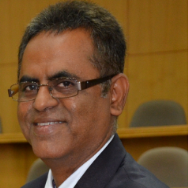
Shanmukhappa A. Angadi
Work place: Department of Computer Science and Engineering, Visvesvaraya Technological University Belagavi - 590018, Karnataka State, India
E-mail: vinay_angadi@yahoo.com
Website:
Research Interests: Computational Science and Engineering, Pattern Recognition, Computer Architecture and Organization, Image Processing, Data Structures and Algorithms, Mathematics of Computing
Biography
Shanmukhappa. A. Angadi is a Professor in the Department of Computer Science and Engineering, Centre for PG Studies, Visvesvaraya Technological University, Belagavi, Karnataka, India. He earned a Bachelor Degree in Electronics and Communication Engineering from Karnataka University, Dharwad and a Master Degree in Computer Engineering from University of Mysore, Mysore and a PhD in Computer science from the Department of Studies in Computer science, University of Mysore, Karnataka, India. He also completed PGDiploma in Opeartions Management (PGDOM), from IGNOU, New Delhi. He has completed many research and consulting projects of AICTE India under RPS, MODROBS, TAPTEC schemes and Research grant scheme of VTU Belagavi. His research areas are Image Processing and Pattern Recognition, Character Recognition, soft computing, Internet of things and Graph Theoretic techniques. He is a co-author of a book on C-programming language. He is life member of professional bodies like ISTE and IETE.
Author Articles
Biometric Person Identification System: A Multimodal Approach Employing Spectral Graph Characteristics of Hand Geometry and Palmprint
By Shanmukhappa A. Angadi Sanjeevakumar M. Hatture
DOI: https://doi.org/10.5815/ijisa.2016.03.06, Pub. Date: 8 Mar. 2016
Biometric authentication systems operating in real world environments using a single modality are found to be insecure and unreliable due to numerous limitations. Multimodal biometric systems have better accuracy and reliability due to the use of multiple biometric traits to authenticate a claimed identity or perform identification. In this paper a novel method for person identification using multimodal biometrics with hand geometry and palmprint biometric traits is proposed. The geometrical information embedded in the user hand and palmprint images are brought out through the graph representations. The topological characterization of the image moments, represented as the virtual nodes of the palmprint image graph is a novel feature of this work. The user hand and palmprint images are represented as weighted undirected graphs and spectral characteristics of the graphs are extracted as features vectors. The feature vectors of the hand geometry and palmprint are fused at feature level to obtain a graph spectral feature vector to represent the person. User identification is performed by using a multiclass support vector machine (SVM) classifier. The experimental results demonstrate, an appreciable performance giving identification rate of 99.19% for multimodal biometric after feature level fusion of hand geometry and palmprint modalities. The performance is investigated by conducting the experiments separately for handgeometry, palmprint and fused feature vectors for person identification. Experimental results show that the proposed multimodal system achieves better performance than the unimodal cues, and can be used in high security applications. Further comparison show that it is better than similar other multimodal techniques.
[...] Read more.Other Articles
Subscribe to receive issue release notifications and newsletters from MECS Press journals